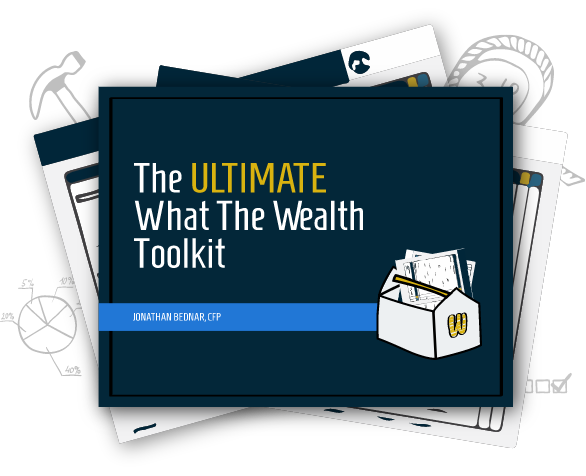In today’s episode, we’ll step away from the doom and gloom to talk about something positive, donor-advised funds. And we’re joined once again by Katie Kavehrad, financial planner at Paradigm Wealth Partners.
Katie and I will discuss how donor advised funds can fit into your tax planning, financial planning, and planned giving. Katie has a background in donor-advised funds, having worked with National Christian Foundation, where she helped high and ultra-high-net-worth families give away cash and non-cash assets for charitable purposes.
Charitable Statistics
Donor-advised funds (DAFs) have been in the news recently. David Green, the founder and former CEO of the Hobby Lobby chain of craft stores, has pledged to give ownership of the company to charity. As Green put it, he’s chosen to “Go purpose, not public.”
When most people think of charitable giving, they think of cash, writing a check to a favorite charity, but there are much more strategic and sophisticated ways to give, and you don’t have to be part of the 1% to employ them.
In 2020, ⅔ of charitable contributions were in the form of non-cash assets, including equity in companies, real estate, and privately held companies. There were more than one million DAFs, and the average size was $159,000. 80% of contributions were from individuals, and 20% were from corporations.
What is a DAF?
A DAF is an investment account created to donate to any charity categorized as a 501(c)(3)by the IRS. A third-party custodian holds the account and the assets inside.
The assets inside a DAF can include publicly traded stocks, real estate, and private companies. DAFs can be a great way to align your core values and dreams with your charitable giving.
Why Use a DAF?
You might ask why use a DAF rather than just give your donation directly to a charity. If you want to give an asset like real estate, a small charity may not have the ability to accept and process that kind of donation. How can they liquidate or otherwise put that donation to work? A DAF makes it easier for charities, especially small ones, to use a contribution immediately.
While you may be charitably inclined, you may not be ready to commit, you may need time to work your gift into your financial or tax planning, or you may want to give the gift time to grow and then make a lump sum cash donation. Or you may prefer to donate after you pass, and a DAF gives you this flexibility.
What are the Tax Advantages of DAFs?
DAFs can offer some significant tax advantages; these are the three primary ones.
A DAF gives the donor an immediate tax deduction for the amount of the fair market value of the asset gifted. It reduces or removes the capital gains taxes upon the eventual sale of the gifted asset. And when you’re in a position where the gift or estate taxes may apply, you can avoid those taxes on assets gifted to the DAF.
DAFs aren’t suited to everyone, but they can be an excellent tool for some as part of their overall financial plan.
DAFs Versus a Private Foundation
If you are familiar with private foundations, you might think they sound a lot like DAFs, and there are similarities. DAFs are a bit like mini private foundations, different in structure but similar in how they’re used.
DAFs are anonymous, whereas information about private foundations is subject to public disclosure, so if anonymity is important to you, a DAF will provide that. They are easier and less expensive to administer than private foundations, which require a lot of complex legal work to set up.
DAFs are like private foundations for the average person who wants to create a charitable legacy; they essentially do the same thing with less hassle and cost!
Who Should Create a DAF?
There are two typical scenarios for those who create DAFs.
A DAF is beneficial when you’ve had a high-income year; maybe you received a large bonus or earned a lot of commissions. If that’s the case, you can use a bunching strategy.
When you have a high-income year, you might find yourself on the borderline between taking the standard deduction on your taxes or being able to take itemized deductions. You can bunch donations to a DAF, take next year’s gifts and give them in the current year. You can bunch 2022 and 2023 to get to the point where you can take itemized deductions rather than standard deductions.
The other scenario is when you’re getting ready to sell a highly-appreciated asset that you don’t want to pay capital gains taxes on and don’t need the proceeds for personal use.
A typical client we see has only about 10% of their total wealth in cash; the other 90% is less liquid assets. When giving to charity, a DAF opens the door to get creative and give from that 90%.
Example of how to use a DAF
Here’s an example:
You buy stock at $50 per share; over time, it appreciates to $100 per share. If you sell that stock and donate the proceeds directly to a charity, you’ll pay 15% or whatever your capital gains rate is on the profits. That leaves you with $85 to donate.
If you create a DAF and instead of donating those proceeds, you donate the stock itself, which is a non-taxable event for you, you won’t owe any capital gains. You’ll get the tax deduction on the fair market value of your donation, the entire $100, and the whole amount of your gift goes to the charity.
Why pay taxes when you plan to give the money away? The charity won’t pay taxes and receives the entire amount of the value of the donation. Pretty neat!
It’s these kinds of scenarios where a financial advisor is really valuable. There is a lot of nuance, and while it’s possible to DIY these sorts of situations, you can miss out on some really great benefits unless you understand all of that nuance.
Disadvantages of DAFs
While DAFs can be a great tax and financial planning tool, they do have some disadvantages.
There are specific grant recommendations you cannot make from a DAF. You can’t earmark money to go to a specific person, so that may be an issue for those wanting to create a scholarship fund. You can’t use DAFs to do things like pay for a table at a banquet or to buy items at a charity auction. Basically, you can’t grant the money to something that you would benefit from.
Once a grant is made into a DAF, it’s irrevocable; you can’t take it back. You don’t have to commit to the same charity, though. If, for example, you have $150,000 in a DAF and plan to give $15,000 a year for ten years to Charity A and Charity A changes its mission or its leadership in year three, does anything you don’t support, you can choose a different charity to receive the donation for the remaining seven years.
The sponsor of the DAF charges a fee for assets under management, usually under 1%. And some sponsors require a minimum balance to keep the DAF open.
Creating a Family Legacy With a DAF
We often see a divide between our older clients and younger clients when it comes to leaving a financial legacy. Those in their 80s and 90s saved every penny they could to leave to their children. This is often a reaction to having lived through the Depression. They know economic calamity can happen at any time, and they want to spare their children. Their financial legacy is leaving money to their children and family.
Clients in their 50s and 60s are much more likely to create a DAF. Their children often don’t need an inheritance; they make more money than their parents made. And they saw how much their parents denied themselves and rightly want to spend some of the money they worked hard to earn enjoying their lives. Nothing wrong with that!
But giving is still important to them, so they create a DAF to support the causes they care about.
A DAF can be a great opportunity to model giving to our children as we model saving and investing. They can be used to create a conversation even with young children. What do we as a family believe, what is important to us, and how can we help? You can create a legacy around generosity.
If you have any questions about DAFs or any other areas of financial planning, reach out to me. You can find Katie here.
And check out my new YouTube channels. The videos are short, walk and talks, where I take a stroll and talk about whatever’s on my mind. And I have a Paradigm Wealth Partners channel too.
Advisors associated with Paradigm Wealth Partners may be either (1) registered representatives with, and securities offered through LPL Financial, Member FINRA/SIPC, and investment advisor representatives of Paradigm Wealth Partners; or (2) solely investment advisor representatives of Paradigm Wealth Partners, and not affiliated with LPL Financial. Investment advice offered through Paradigm Wealth Partners, a registered investment advisor. Paradigm Wealth Partners is a separate entity from LPL Financial.
Katie Kavehrad is solely an investment advisor representative of Paradigm Wealth Partners, and not affiliated with LPL Financial.
Listen to the Full Episode:
What You’ll Learn In Today’s Episode:
- Misconceptions around charitable giving and what it actually means.
- The form that the majority of charitable contributions come in.
- The importance of aligning your financial plan with your purpose and vision.
- What a DAF is and what it’s commonly used for.
- The disadvantages of a DAF.
- The tax benefits that come with gifts or donations.
Ideas Worth Sharing:
“I’m a big believer that once you begin giving and if you’re charitably inclined, it really becomes a joyful process and kind of contagious.” – Katie Kavehrad
“Many people believe that charitable giving is just writing a check or giving cash, but really, there are so many more strategic and sophisticated ways to give to charity these days – even for the average investor.” – Katie Kavehrad
“A majority of contributions to charity were not checks or cash. Donors today are using things like equity compensation, real estate, and even privately held companies to give to charity.” – Katie Kavehrad
Resources In Today’s Episode:
- Katie Kavehrad: LinkedIn
- Jonathan Bednar: Email | Twitter | LinkedIn
- What The Wealth?! by Jonathan Bednar
Enjoy the show? Use the Links Below to Subscribe:





